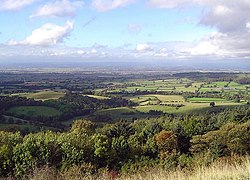Vale of Mowbray

The Vale of Mowbray (sometimes mistakenly referred to as the Vale of York) is a stretch of low-lying land between the North York Moors and the Hambleton Hills to the east and the Yorkshire Dales to the west. To the north lie the Tees Valley lowlands and to the south the Vale of Mowbray becomes the Vale of York proper.
The Vale of Mowbray is distinguishable from the Vale of York by its meandering rivers and more undulating landscape.
The main characteristic of the Vale of Mowbray is the fertile agricultural land used for crops and permanent grassland, though isolated pockets of woodland remain. The roads in the Vale of Mowbray are characteristically contained by low hedges with wide verges. The villages are often linear following the major through road, the houses are generally brick built with pantile roofs.
Description
The vale takes its name from the family who were granted the rights to the land after the Norman Conquest of 1066. Robert de Mowbray, whose family had a stronghold at Thirsk Castle, was given the land by William the Conqueror in 1086.[1]
The Natural England definition of the boundaries of the Vale of Mowbray are the edge of the North York Moors in the east up to the A19/A172 junction; directly across to the junction at Scotch Corner on the A1(M), then straight down the A1(M) for a western boundary and the rough line from the A168 at Dishforth to Thirsk in the east.[2]

Features
Notable settlements
Major roads
- A1 North-South
- A19 North-South
- A167 North-South
- A684 East-West
- A172 North-South
Railways
- East Coast Main Line
- Northallerton–Eaglescliffe line
- Northallerton West–Redmire (2015 - now open for 22 miles from Northallerton West to Redmire)
- Eryholme–Richmond branch line (closed)
- Leeds–Northallerton railway (closed)
Rivers
References
- ↑ Grainge 1859, pp. 1–10.
- ↑ "NCA Profile: 24 Vale of Mowbray - NE442" (PDF). 23 May 2013. p. 3. http://publications.naturalengland.org.uk/publication/9856012. Retrieved 20 March 2018.
Sources
- Grainge, William (1859). The Vale of Mowbray: a historical and topographical account of Thirsk and its neighbourhood. London: Simpkin, Marshall & Co.. OCLC 559956399.
Outside links
- Location map: 54°20’31"N, 1°26’6"W
- Vale of Mowbray pdf